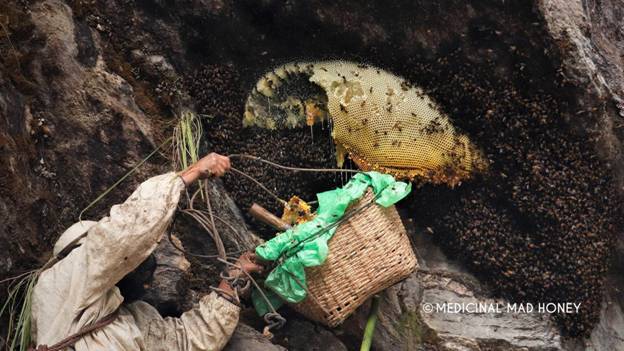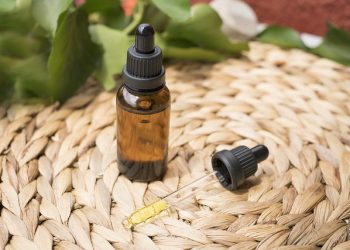The rare intoxicating substance called mad honey was produced through bees gathering nectar from rhododendron plants during hundreds of years of human history. Many cultures have been fascinated by mad honey since it offers intoxicating properties that result in hallucinogenic effects. The toxic honey affects the mind and body to produce euphoria along with dizziness and severe poisoning while bees collect the nectar from rhododendron species.
Origins and Early Use
People have been collecting and harvesting mad honey from the Black Sea region across thousands of years, especially in Turkey and high cliffs of Nepal. Native residents in these regions discovered the distinctive honey made by bees which collected rhododendron nectar for honey. The potency of Grayanotoxins has long been in use since ancient times and has been a valuable item in the human world.
Mad honey served Greek and Roman society both as a medical treatment and recreational material. Xenophon the ancient Greek historian, philosopher and military leader wrote about that strange honey during his narratives from 400 BCE. Consuming the substance led soldiers to become confused and dizzy as well as experience hallucinations. The disorienting effects mad honey produced among people resulted in the common name of “mad honey.”
The honey substance served two functions simultaneously since it functioned both as a combat strategy and a matter of scientific interest. Ancient historical records show that Romans were among the groups who used mad honey in battle as a weapon against their enemies. The enemies after consuming poisonous mad honey resulted in temporary incapacitation or extended disorientation of their opponents. Through its use as a battlefield tactic the attackers gained simpler control of the battlefield. Through the ages the Ottoman Empire and the succeeding Byzantine Empire used mad honey as a weapon of war or disruption.

The Medicinal Use of Mad Honey
Throughout history the ancient medical practices of mad honey treatment developed independently of combat uses. Academic science believes that the psychoactive ingredient grayanotoxin found in mad honey possesses multiple medical benefits. Traditional healers who practiced medicine in ancient times utilized the honey to handle different medical conditions spanning digestive disorders through severe conditions such as hypertension across various cultural traditions.
People in the Himalayan territories of Nepal utilized mad honey for healing high blood pressure and diabetes while also treating sexual disorders with this honey. Modern beliefs indicate that honey possesses natural sedating characteristics which help lower blood pressure and control stress inside the body. Ancient traditions valued natural medicine because mad honey was believed both to create sexual desire and improve erotic capabilities.
Ritualistic and Religious Uses
Mad honey played an essential religious role in addition to its medical purposes. The practice of consuming this honey existed during ancient times when people linked its effects to divine enlightenment and intoxication. In various cultures people used mad honey as a spiritual practice to attain trance states along with divine wisdom. Traditional people from the Black Sea region included mad honey in their religious worship practice. Some shamans used Mad honey to shift their consciousness into different states with the aim of enabling spirit or deity communication.

The Benefits and Effects of Mad Honey
The historical importance of mad honey emerges from its psychoactive nature but consumers should understand the positive and negative aspects linked to consuming this substance. The positive benefits and effects of mad honey have received scientific study by modern researchers who suggest this honey maintains medicinal properties at particular consumption levels.
Cardiovascular Health: Previous therapeutic uses of mad honey involved its application for patients with high blood pressure. Research today indicates that grayanotoxins facilitate vasodilation to lower blood pressure but further scientific investigations need to confirm their clinical value as medical therapy.
Antioxidant Properties: The antioxidants present in mad honey resemble those found in other natural products that help minimize oxidative stress effects on the body. The preventive mechanisms of cellular damage work through antioxidants while antioxidants help slow down aging and prevent chronic diseases.
Aphrodisiac Effects: Historical accounts indicate that people have been using mad honey as a sexual stimulant throughout time. After enjoying mad honey people might experience mood elevation and serenity that could enhance both their sexual desire and enjoyment.
Cognitive and Mood Enhancement: People seek to use Mad honey because its active compounds cause euphoria and perceptual alterations. People who consume Mad honey often see better creativity alongside relaxed emotions and a general enhancement of their mood.
The positive characteristics of mad honey do not eliminate the dangerous side effects it can produce. The psychoactive components in mad honey which create its effects also function as poisonous substances.
Conclusion
Through centuries the substance known as Mad honey has both fascinated and intrigued human consciousness because of its historical background and multi-purpose applications. Throughout human history many cultures have utilized mad honey both as ancient medicine for healing and shamanic practices. The enchanting psychoactive quality of the honey has driven its popularity although scientists continue to investigate both medical advantages and dangerous potential of this substance. Natural substances require balanced usage because people must honor heritage alongside awareness of associated dangers. Mad honey stands as an intriguing historical element with its status as either medicine or spiritual implement or historical artifact.







